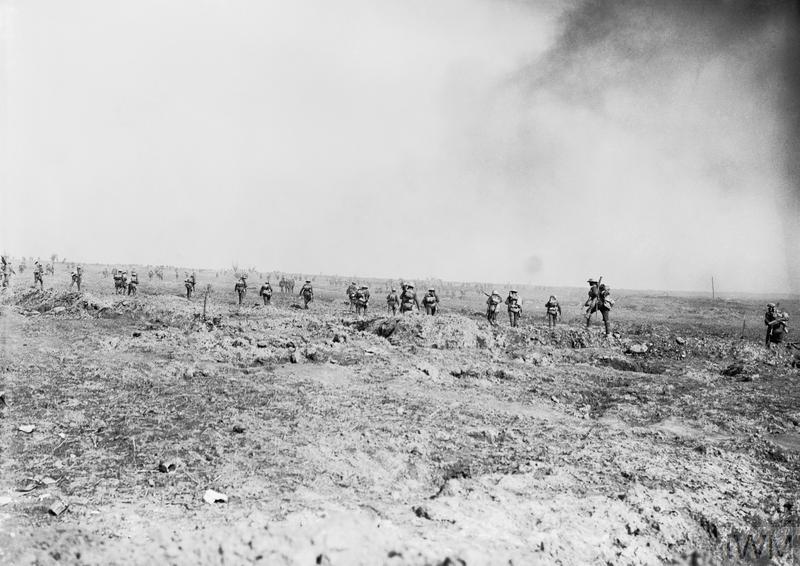16th (Irish) Division, Battle of Ginchy.

|
| German prisoners (taken at the Battle of Ginchy) on the Meaulte-Fricourt road, 9 September 1916. |
The Battle for Ginchy was fought on 9 September 1916, during the second of the three operational phases of the Battle of the Somme, and resulted in the capture of the German-held village by the 16th (Irish) Division.
Following the Battle of Guillemont from 3-6 September, the British were to advance to ground that over-watched the German's third line positions in preparation for an attack planned for mid-September. The advance had begun on 3 September, when the 7th Division had captured Ginchy and then lost it following a German counter-attack. Now it was the 16th (Irish) Division's turn.
The Irish Division attacked with 47 Brigade right, 48 Brigade left, with the village of Ginchy as the latter's objective, and 49 Brigade in support. The attack was to be made by four battalions, with two leap-frogging past the two in the lead on the first objective - the road running from Delville Wood to the middle of the village. These two battalions would pass through the lead battalions at Zero Hour +40 minutes. As the Division would not advance until late in the afternoon, Zero Hour was set for 1645 hours. This was to allow enough time for the battalions to consolidate their positions before last light but deny the Germans sufficient time to counter-attack in daylight. Unfortunately, it also meant that the Germans were able to bombard, for example, the 7th Battalion The Royal Irish Rifles (7 RIR) for nine hours as it prepared assembly trenches some 200 yards forward of its main positions. Due to the poor passage of information, the British artillery was also dropping rounds on 7 RIR's digging parties. The combined effect was that by 1400 hours the commanding officer reported that his battalion's strength had been reduced to 150 bayonets for the attack. Therefore, 49 Brigade moved forward the 7th Battalion The Royal Irish Fusiliers behind 7 RIR to reinforce 48 Brigade.
 The attack went in and when the 9th Battalion The Royal Dublin Fusilers leap-frogged past 7 RIR many Riflemen, stirred by their success, decided to advance with the 'Dubs' to and beyond the second objective until recovered by one of their officers to consolidate their positions by midnight. On the right, 47 Brigade had advanced into effective enemy machine-gun fire from Ginchy and were held up. When 49 Brigade was ordered forward with its remaining three battalions, the 7th Battalion and the 8th Battalion The Royal Inniskilling Fusiliers, with the 8th Battalion The Royal Irish Fusiliers, it advanced into enemy machine-gun fire and artillery bombardment. As there was no prospect of any further gains, their positions were adjusted to afford right-flank protection to the gains made by 48 Brigade in Ginchy on the left.
The attack went in and when the 9th Battalion The Royal Dublin Fusilers leap-frogged past 7 RIR many Riflemen, stirred by their success, decided to advance with the 'Dubs' to and beyond the second objective until recovered by one of their officers to consolidate their positions by midnight. On the right, 47 Brigade had advanced into effective enemy machine-gun fire from Ginchy and were held up. When 49 Brigade was ordered forward with its remaining three battalions, the 7th Battalion and the 8th Battalion The Royal Inniskilling Fusiliers, with the 8th Battalion The Royal Irish Fusiliers, it advanced into enemy machine-gun fire and artillery bombardment. As there was no prospect of any further gains, their positions were adjusted to afford right-flank protection to the gains made by 48 Brigade in Ginchy on the left.
(Above: Battle of Ginchy. Supporting infantry walk forward up the slope into the bombardment, 9th September 1916.
(© IWM (Q 1306))
The Inniskillings casualties were 23 officers and 403 other ranks (ORs), the Rifles 10 officers and 309 ORs and the Irish Fusiliers on the same scale with the 7th Battalion casualties alone numbering 13 officers and 130 ORs. The 16th (Irish) Division was relieved the following day.





